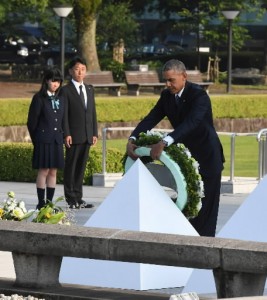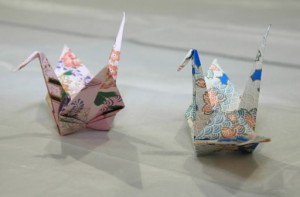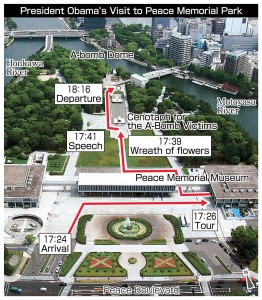President Obama offers paper cranes, and message of peace, at Hiroshima Peace Memorial Park
May 28, 2016
During his visit to the Hiroshima Peace Memorial Museum, in Naka Ward, U.S. President Barack Obama wrote a message in the museum guestbook and gently laid two paper cranes on the desk after he finished. The paper cranes were an unexpected gift from Mr. Obama. Responding to a question from Japanese Prime Minister Shinzo Abe, the president said that he made the paper cranes himself, with a bit of help. In all, Mr. Obama had made four paper cranes and he gave the other two to two children from Hiroshima who were at the museum with him, an elementary school student and a junior high school student.
President Obama arrived at the Hiroshima Peace Memorial Park at 5:24 p.m. and entered the museum. He listened to Fumio Kishida, the Japanese minister of foreign affairs, explain the exhibit of paper cranes that were folded by Sadako Sasaki, a girl who died at the age of 12 after developing leukemia as a result of her exposure to the A-bomb’s radiation 10 years before. Sadako made these cranes during her time in the hospital. The president also saw several other artifacts related to the atomic bombing. Yasuyoshi Komizo, the chairperson of the Hiroshima Peace Culture Foundation, accompanied the group, too, and commented, “He stopped in front of each artifact, listened to the explanation, and sometimes asked questions.”
Mr. Obama spent about 10 minutes in the museum. In April, when the meeting of foreign ministers took place in Hiroshima, the foreign ministers from seven nations, including U.S. Secretary of State John Kerry, visited the museum as well, spending most of their time in the main building. That visit lasted about 50 minutes, which was 20 minutes longer than the scheduled time. Kenji Shiga, the director of the museum, said, “Frankly speaking, I wish the president had spent more time in the museum.”
Mr. Obama wore a solemn expression after he left the museum. With Mr. Abe, the president walked slowly toward the Cenotaph for the A-bomb Victims. After laying a wreath of white flowers, he stood erect and closed his eyes for five seconds, as if making a silent prayer. He then made a speech that lasted for 17 minutes. He began his address by saying, “Seventy-one years ago, on a bright cloudless morning, death fell from the sky and the world was changed.” His tone of voice gradually grew more impassioned and, as he gestured, he would at times cast a serious gaze at the audience seated in front of him.
His expression changed after he finished speaking and approached the A-bomb survivors in the front row. He gripped the hand of Sunao Tsuboi, 91, the chairperson of the Japan Confederation of A- and H-Bomb Sufferers Organizations (Nihon Hidankyo), and listened carefully to Mr. Tsuboi’s words. Occasionally, he showed a warm smile. Mr. Obama then moved to Shigeaki Mori, 79, a local historian and resident of Nishi Ward, who broke down in emotion. The president put a hand on Mr. Mori’s back and the two men embraced as they spoke.
President Obama showed a gentle nature toward young people, too. He held out his hand to Hinako Tokunaga, 14, a third-year student from Himi Junior High School in Nagasaki, and shook hands with her. Ms. Tokunaga said, “I was surprised. His hand was so big and warm.”
Walking north from the cenotaph, the president paused at a spot by the A-bombed building that is now the Rest House. He gazed at the Children’s Peace Monument, which is crowned by a statue of Sadako Sasaki holding aloft a large crane, and the Atomic Bomb Dome. He nodded as he listened to explanations from Mr. Kishida. Mr. Obama said that the park is a very important place for peace, then he departed for home.
The president initially arrived at the Hiroshima Heliport at 5:04 p.m. and left from there at 6:36 p.m. In total, his visit to Hiroshima lasted 1 hour and 32 minutes, with 52 of those minutes spent at the Peace Memorial Park.
(Originally published on May 28, 2016)
President Obama arrived at the Hiroshima Peace Memorial Park at 5:24 p.m. and entered the museum. He listened to Fumio Kishida, the Japanese minister of foreign affairs, explain the exhibit of paper cranes that were folded by Sadako Sasaki, a girl who died at the age of 12 after developing leukemia as a result of her exposure to the A-bomb’s radiation 10 years before. Sadako made these cranes during her time in the hospital. The president also saw several other artifacts related to the atomic bombing. Yasuyoshi Komizo, the chairperson of the Hiroshima Peace Culture Foundation, accompanied the group, too, and commented, “He stopped in front of each artifact, listened to the explanation, and sometimes asked questions.”
Mr. Obama spent about 10 minutes in the museum. In April, when the meeting of foreign ministers took place in Hiroshima, the foreign ministers from seven nations, including U.S. Secretary of State John Kerry, visited the museum as well, spending most of their time in the main building. That visit lasted about 50 minutes, which was 20 minutes longer than the scheduled time. Kenji Shiga, the director of the museum, said, “Frankly speaking, I wish the president had spent more time in the museum.”
Mr. Obama wore a solemn expression after he left the museum. With Mr. Abe, the president walked slowly toward the Cenotaph for the A-bomb Victims. After laying a wreath of white flowers, he stood erect and closed his eyes for five seconds, as if making a silent prayer. He then made a speech that lasted for 17 minutes. He began his address by saying, “Seventy-one years ago, on a bright cloudless morning, death fell from the sky and the world was changed.” His tone of voice gradually grew more impassioned and, as he gestured, he would at times cast a serious gaze at the audience seated in front of him.
His expression changed after he finished speaking and approached the A-bomb survivors in the front row. He gripped the hand of Sunao Tsuboi, 91, the chairperson of the Japan Confederation of A- and H-Bomb Sufferers Organizations (Nihon Hidankyo), and listened carefully to Mr. Tsuboi’s words. Occasionally, he showed a warm smile. Mr. Obama then moved to Shigeaki Mori, 79, a local historian and resident of Nishi Ward, who broke down in emotion. The president put a hand on Mr. Mori’s back and the two men embraced as they spoke.
President Obama showed a gentle nature toward young people, too. He held out his hand to Hinako Tokunaga, 14, a third-year student from Himi Junior High School in Nagasaki, and shook hands with her. Ms. Tokunaga said, “I was surprised. His hand was so big and warm.”
Walking north from the cenotaph, the president paused at a spot by the A-bombed building that is now the Rest House. He gazed at the Children’s Peace Monument, which is crowned by a statue of Sadako Sasaki holding aloft a large crane, and the Atomic Bomb Dome. He nodded as he listened to explanations from Mr. Kishida. Mr. Obama said that the park is a very important place for peace, then he departed for home.
The president initially arrived at the Hiroshima Heliport at 5:04 p.m. and left from there at 6:36 p.m. In total, his visit to Hiroshima lasted 1 hour and 32 minutes, with 52 of those minutes spent at the Peace Memorial Park.
(Originally published on May 28, 2016)










